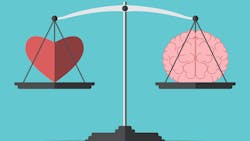Practice Building 101: The worst thing versus the best things for dentists and patients
It's cold and snowy in some parts of the country, and on days the weather is so bad, you just know your schedule will be wiped out. Should you even try to get to your office?
When you have days like this, turn them into something productive, or maybe just spend time with your spouse and kids. When I have down time with nothing to do, I think back over my 44 years of private practice. What often comes to mind are some of the worst things.
I remember the day I put a post drill right out the side of a tooth and only to the buccal. I wish I’d taken a picture of it because seeing the drill come through the buccal tissue was shocking. Fortunately, I had the method and skill to make the repair, and the tooth lasted the 80-year-old the rest of her 92-year life. We’ve all had terrible failures of our cases.
More insights from Dr. Hoos
Is there room for improvement? Here's how to get better
How to give painless injections
Going above and beyond
We have an obligation to our patients to provide the highest quality care we can, and sometimes the answer needs to be “no.” Here’s a great example. My patient required a six-unit anterior case to be done over after she fell and broke off her front teeth. The case was 25 years old and things were breaking down. I had not done the original case and the patient had some financial limits.
Now the case was much more complex and twice as expensive. The patient was not the least bit understanding about how much it would cost, and she Ieft the office very angry. I felt terrible. But the worst thing I could have done would have been to try to salvage the broken teeth because the case would have failed. I had to tell her no.
I believe that the best thing we can do for patients is under-promise and over-deliver. This means doing the extras and showing patients they’re the center of your patient care. I’ve also been doing something else for years. I ask the patient “When is your birthday? Did I get you a present? No?! Well then, happy birthday.”
I carefully choose a patient who needs dentistry but just cannot do it for whatever reason. I tell them, “I choose a couple of patients a year to provide some free treatment, and I’ve chosen you.” I let them know this is not charity. This treatment can be one of the best things to do for yourself, and your staff needs to know that you’re doing it.
The importance of patient-centered care
I speak often about relationships and patient-centered dentistry, and that if you find yourself angry or frustrated, try to figure out why. Is it the lack of “fair pay” from insurance companies, or do you think your patients don’t appreciate what you’re doing for their dental health? Is it issues you cannot get a handle on, or are you running behind? Dentists carry tremendous burdens, especially if you’re a solo dentist business owner.
When you think others are the problem, it’s generally a good idea to look in the mirror and ask, “Am I the problem? Do I really put myself in the place of the patient when someone is coming at them with a drill that spins at 500,000 rpm and makes a terrible noise? Or do I really understand what it means to say to a patient, ‘You’re going to lose all your teeth and it will cost $60,000 to have something removable in your mouth.’” I always present the fee with some understanding of what spending this money means.
We must face the worst things in our practices head on, and problem solve with the best interests of our patients in mind. But we also have to think about the best things we can do for everyone involved, and then proactively do them. Balancing the art, science, and business of dentistry is not easy, but we can do it. Have a productive month, and remember to be nice to yourself and everyone else.
Editor's note: This article appeared in the December 2023 print edition of Dental Economics magazine. Dentists in North America are eligible for a complimentary print subscription. Sign up here.
About the Author
Jeffrey C. Hoos, DMD
Jeffrey C. Hoos, DMD, a 1978 graduate of the Tufts University School of Dental Medicine, started his private practice as a one-operatory walk-up and grew it to a four-doctor practice with 25 staff members. He lectures on innovative techniques that balance the art, science, and business of dentistry. He is one of the first general dentists to be Brånemark certified for implant placement, and his office has become a teaching center for restorative and implant dentistry. Contact him at [email protected].

